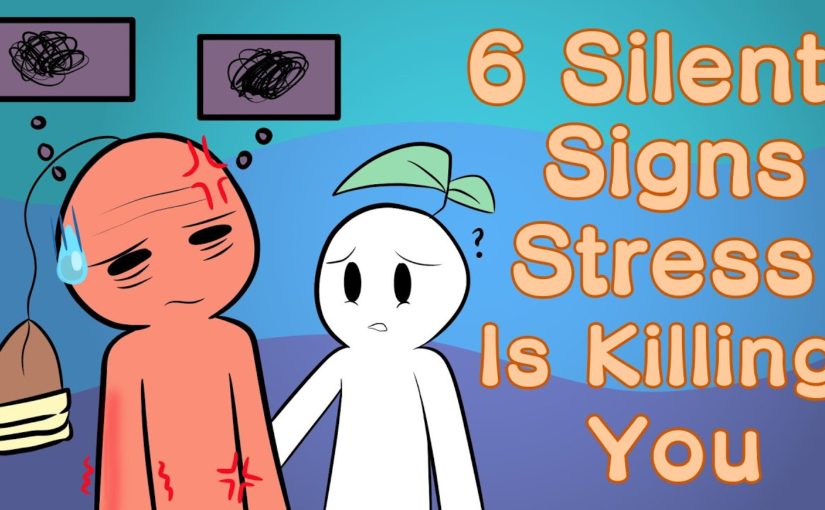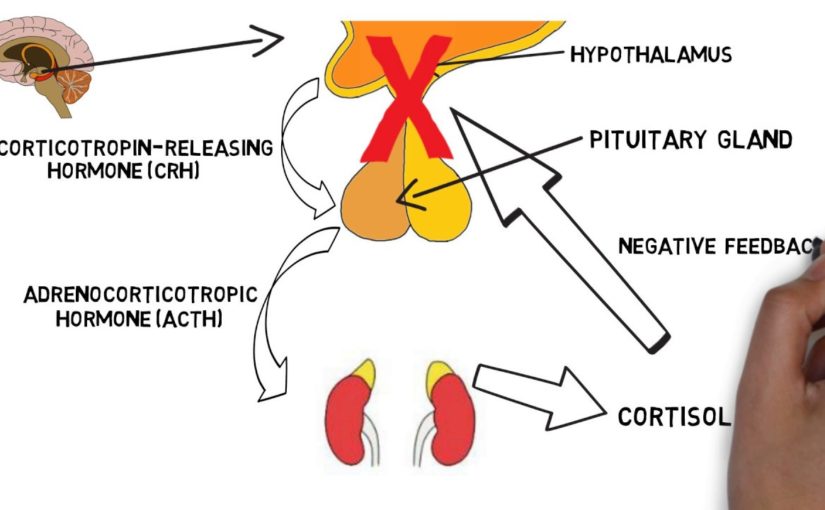– [Narrator] Hey, Psych2Goers,
welcome back to our channel. Have you been feeling stressed out lately? Stress can sometimes feel
like an unwelcome entity, much like how you might feel if you’re rushing assignments
or going out on a first date. It’s your body’s natural reaction when faced with challenges
and can help in short bursts. But feeling stressed constantly can have many negative
effects on your daily life. To help become more aware of what your body is trying to tell you, we will address six silent signs that stress might be killing you. Number one, your skin
is itchier than usual. Itchy skin can have various
causes such as allergies, insect bites, or even black mold spores. But have you noticed
your skin getting itchier without being exposed
to any of these things? High levels of stress can cause your skin to break out because of the effects stress
has on the immune system. Being stressed leads your immune system to release the chemical histamine, which weakens your immune system. As a result, any external factors such as detergent, lotions, and heat, which you may have not
been sensitive to before, can cause an allergic reaction. To treat this, apply a cool, damp towel
to the affected areas. Number two, you have chronic
migraines and headaches. Do you feel like you
happen to have migraines every time you feel stressed? While many factors contribute to migraines, a study conducted in 2014 by the American Academy of Neurology showed that stress is
directly linked to headaches and migraines. This is mainly due to
the chronic inflammation that stress causes to the
brain, which affects blood flow and ultimately results in
headaches and migraines. Practicing routines to reduce stress may help alleviate these
occurrences from happening. Three, you’re developing wrinkles. Have you ever looked in the mirror and felt like you have a lot of wrinkles for someone your age? Of course, this might have
something to do with genetics and how well you take care of your skin, but it’s important to notice the effect that stress can have
on your physical appearance. A study published in the journal “Brain: Behavior and Immunity” in 2009 showed that stress can cause a reduction in collagen production, making you more likely to
develop wrinkles and fine lines. So although it’s very hard to tell, try to elevate how you feel and determine if stress might
be making your skin condition worse than it should. Number four, you forget things. Are you someone whose
memory was always good, but now you tend to forget
the simplest things? Well, one of the main reasons
for this might be stress, and this is backed up by research. A study conducted in 2014 by
the Journal of Neuroscience linked high levels of cortisol, which are the hormones released
when you experience stress, to short-term memory loss. Additionally, researchers
from the University of Iowa found that chronic stress leads to loss of synopsis in
the prefrontal cortex where our short-term memories are stored. If you feel like you’re
steadily forgetting more and more things as days
pass, you may consider stress as one of the reasons
why this is happening. Number five, your digestive
system is giving you problems. Have you been feeling
uncomfortable after a meal no matter what you eat? Stress can cause a strong
reaction in your digestive system leading your body to produce higher amounts of digestive acid, which is responsible for the discomfort and subsequent problems
that you might experience.

These problems include bloating,
cramping, and diarrhea, according to Dr. Deborah Rhodes, a Mayo Clinic medicine physician. Additionally, the American
Institute of Stress has reported that your digestive system can be affected by the
increased heart rate from stress, causing
heartburn and acid reflux. Taking an over-the-counter
antiacid, or simple ginger tea, can reduce discomfort. And number six, your body
weight is fluctuating. Are you someone who tends
to check their weight? Have you noticed any unusual changes? Shauna Levine, a clinical
instructor of medicine at Icahn School of Medicine states that the way stress
affects your body weight is by releasing cortisol, and this hormone will
inhibit your body’s ability to process blood sugar while
changing the way your body metabolizes fat,
carbohydrates, and protein. As a result of all these changes, as well as the effects that
stress has on undereating and overeating, you might start to notice unusual weight fluctuations. If you’re undereating,
try snacking on nuts with high protein
content to help you. If you’re overeating,
try to eat more fiber, since this will fill you up. Although these points have
individual treatments, you will eventually have to address the stress causing
all these problems. Stress isn’t all bad, as short bursts of stress
can help you, but you need to try things that can help with long-term stress, such as mindfulness, meditation, or yoga. Learning how to deal with stress through different techniques will help you avoid the emotional and physical
burden that comes with it. Do you relate to any of these signs? Let us know in the comments below. If your stress persists, or you have any concerns
about your symptoms, please see a healthcare professional. Psych2Go is not certified to
provide official treatments or advice, and serious issues
require professional advice. Thanks so much for watching our video. What are the different ways that you like to cope with your stress? What has been the most effective for you? We’d love everyone to share and help each other out in the comments. If you enjoyed it, please consider giving this video a like, and subscribing to our channel to see more content like this. We’ll see you at the next one.
As found on YouTubeAlzheimer’s Dementia Brain Health ➫➬ ꆛシ➫ I was losing my memory, focus – and mind! And then… I got it all back again. Case study: Brian Thompson There’s nothing more terrifying than watching your brain health fail. You can feel it… but you can’t stop it. These problems include bloating,
cramping, and diarrhea, according to Dr. Deborah Rhodes, a Mayo Clinic medicine physician. Additionally, the American
Institute of Stress has reported that your digestive system can be affected by the
increased heart rate from stress, causing
heartburn and acid reflux. Taking an over-the-counter
antiacid, or simple ginger tea, can reduce discomfort. And number six, your body
weight is fluctuating. Are you someone who tends
to check their weight? Have you noticed any unusual changes? Shauna Levine, a clinical
instructor of medicine at Icahn School of Medicine states that the way stress
affects your body weight is by releasing cortisol, and this hormone will
inhibit your body’s ability to process blood sugar while
changing the way your body metabolizes fat,
carbohydrates, and protein. As a result of all these changes, as well as the effects that
stress has on undereating and overeating, you might start to notice unusual weight fluctuations. If you’re undereating,
try snacking on nuts with high protein
content to help you. If you’re overeating,
try to eat more fiber, since this will fill you up. Although these points have
individual treatments, you will eventually have to address the stress causing
all these problems. Stress isn’t all bad, as short bursts of stress
can help you, but you need to try things that can help with long-term stress, such as mindfulness, meditation, or yoga. Learning how to deal with stress through different techniques will help you avoid the emotional and physical
burden that comes with it. Do you relate to any of these signs? Let us know in the comments below. If your stress persists, or you have any concerns
about your symptoms, please see a healthcare professional. Psych2Go is not certified to
provide official treatments or advice, and serious issues
require professional advice. Thanks so much for watching our video. What are the different ways that you like to cope with your stress? What has been the most effective for you? We’d love everyone to share and help each other out in the comments. If you enjoyed it, please consider giving this video a like, and subscribing to our channel to see more content like this. We’ll see you at the next one.As found on YouTubeAlzheimer’s Dementia Brain Health ➫➬ ꆛシ➫ I was losing my memory, focus – and mind! And then… I got it all back again. Case study: Brian Thompson There’s nothing more terrifying than watching your brain health fail. You can feel it… but you can’t stop it.
These problems include bloating,
cramping, and diarrhea, according to Dr. Deborah Rhodes, a Mayo Clinic medicine physician. Additionally, the American
Institute of Stress has reported that your digestive system can be affected by the
increased heart rate from stress, causing
heartburn and acid reflux. Taking an over-the-counter
antiacid, or simple ginger tea, can reduce discomfort. And number six, your body
weight is fluctuating. Are you someone who tends
to check their weight? Have you noticed any unusual changes? Shauna Levine, a clinical
instructor of medicine at Icahn School of Medicine states that the way stress
affects your body weight is by releasing cortisol, and this hormone will
inhibit your body’s ability to process blood sugar while
changing the way your body metabolizes fat,
carbohydrates, and protein. As a result of all these changes, as well as the effects that
stress has on undereating and overeating, you might start to notice unusual weight fluctuations. If you’re undereating,
try snacking on nuts with high protein
content to help you. If you’re overeating,
try to eat more fiber, since this will fill you up. Although these points have
individual treatments, you will eventually have to address the stress causing
all these problems. Stress isn’t all bad, as short bursts of stress
can help you, but you need to try things that can help with long-term stress, such as mindfulness, meditation, or yoga. Learning how to deal with stress through different techniques will help you avoid the emotional and physical
burden that comes with it. Do you relate to any of these signs? Let us know in the comments below. If your stress persists, or you have any concerns
about your symptoms, please see a healthcare professional. Psych2Go is not certified to
provide official treatments or advice, and serious issues
require professional advice. Thanks so much for watching our video. What are the different ways that you like to cope with your stress? What has been the most effective for you? We’d love everyone to share and help each other out in the comments. If you enjoyed it, please consider giving this video a like, and subscribing to our channel to see more content like this. We’ll see you at the next one.As found on YouTubeAlzheimer’s Dementia Brain Health ➫➬ ꆛシ➫ I was losing my memory, focus – and mind! And then… I got it all back again. Case study: Brian Thompson There’s nothing more terrifying than watching your brain health fail. You can feel it… but you can’t stop it. These problems include bloating,
cramping, and diarrhea, according to Dr. Deborah Rhodes, a Mayo Clinic medicine physician. Additionally, the American
Institute of Stress has reported that your digestive system can be affected by the
increased heart rate from stress, causing
heartburn and acid reflux. Taking an over-the-counter
antiacid, or simple ginger tea, can reduce discomfort. And number six, your body
weight is fluctuating. Are you someone who tends
to check their weight? Have you noticed any unusual changes? Shauna Levine, a clinical
instructor of medicine at Icahn School of Medicine states that the way stress
affects your body weight is by releasing cortisol, and this hormone will
inhibit your body’s ability to process blood sugar while
changing the way your body metabolizes fat,
carbohydrates, and protein. As a result of all these changes, as well as the effects that
stress has on undereating and overeating, you might start to notice unusual weight fluctuations. If you’re undereating,
try snacking on nuts with high protein
content to help you. If you’re overeating,
try to eat more fiber, since this will fill you up. Although these points have
individual treatments, you will eventually have to address the stress causing
all these problems. Stress isn’t all bad, as short bursts of stress
can help you, but you need to try things that can help with long-term stress, such as mindfulness, meditation, or yoga. Learning how to deal with stress through different techniques will help you avoid the emotional and physical
burden that comes with it. Do you relate to any of these signs? Let us know in the comments below. If your stress persists, or you have any concerns
about your symptoms, please see a healthcare professional. Psych2Go is not certified to
provide official treatments or advice, and serious issues
require professional advice. Thanks so much for watching our video. What are the different ways that you like to cope with your stress? What has been the most effective for you? We’d love everyone to share and help each other out in the comments. If you enjoyed it, please consider giving this video a like, and subscribing to our channel to see more content like this. We’ll see you at the next one.As found on YouTubeAlzheimer’s Dementia Brain Health ➫➬ ꆛシ➫ I was losing my memory, focus – and mind! And then… I got it all back again. Case study: Brian Thompson There’s nothing more terrifying than watching your brain health fail. You can feel it… but you can’t stop it.
These problems include bloating,
cramping, and diarrhea, according to Dr. Deborah Rhodes, a Mayo Clinic medicine physician. Additionally, the American
Institute of Stress has reported that your digestive system can be affected by the
increased heart rate from stress, causing
heartburn and acid reflux. Taking an over-the-counter
antiacid, or simple ginger tea, can reduce discomfort. And number six, your body
weight is fluctuating. Are you someone who tends
to check their weight? Have you noticed any unusual changes? Shauna Levine, a clinical
instructor of medicine at Icahn School of Medicine states that the way stress
affects your body weight is by releasing cortisol, and this hormone will
inhibit your body’s ability to process blood sugar while
changing the way your body metabolizes fat,
carbohydrates, and protein. As a result of all these changes, as well as the effects that
stress has on undereating and overeating, you might start to notice unusual weight fluctuations. If you’re undereating,
try snacking on nuts with high protein
content to help you. If you’re overeating,
try to eat more fiber, since this will fill you up. Although these points have
individual treatments, you will eventually have to address the stress causing
all these problems. Stress isn’t all bad, as short bursts of stress
can help you, but you need to try things that can help with long-term stress, such as mindfulness, meditation, or yoga. Learning how to deal with stress through different techniques will help you avoid the emotional and physical
burden that comes with it. Do you relate to any of these signs? Let us know in the comments below. If your stress persists, or you have any concerns
about your symptoms, please see a healthcare professional. Psych2Go is not certified to
provide official treatments or advice, and serious issues
require professional advice. Thanks so much for watching our video. What are the different ways that you like to cope with your stress? What has been the most effective for you? We’d love everyone to share and help each other out in the comments. If you enjoyed it, please consider giving this video a like, and subscribing to our channel to see more content like this. We’ll see you at the next one.As found on YouTubeAlzheimer’s Dementia Brain Health ➫➬ ꆛシ➫ I was losing my memory, focus – and mind! And then… I got it all back again. Case study: Brian Thompson There’s nothing more terrifying than watching your brain health fail. You can feel it… but you can’t stop it.


